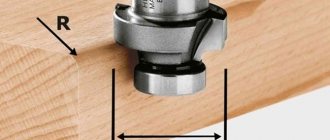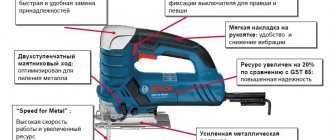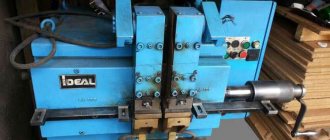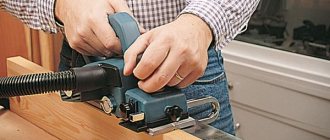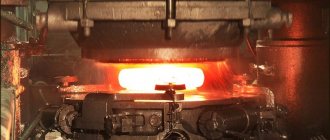Home | Milling cutting
Using the milling cutting method, structures of any size and configuration can be manufactured. RPK "City Printing House" uses modern equipment that allows it to produce products of varying complexity. A personal manager is responsible for each order.
| Price per 1 linear meter, rub. | |||||
| Material thickness, mm | |||||
| Material | 1-3 | 4-8 | 9-12 | 13-20 | |
| 1 | Plexiglas | 30 rub. | 40 rub. | 85 rub. | 140 rub. |
| 2 | Wood, chipboard | 55 rub. | 70 rub. | 85 rub. | 130 rub. |
| 3 | Plywood | 30 rub. | 40 rub. | 85 rub. | 140 rub. |
| 4 | Aluminum | 60 rub. | 90 rub. | 125 rub. | 180 rub. |
| 5 | Polystyrene | 30 rub. | 50 rub. | 60 rub. | — |
| 6 | Composite | 38 rub. | 45 rub. | — | — |
| 7 | PVC plastic | 30 rub. | 40 rub. | 45 rub. | 60 rub. |
| 8 | MDF | 30 rub. | 40 rub. | 45 rub. | 60 rub. |
Submit your application
Milling cutting technology is used for the production of non-standard advertising products:
- figured plates;
- illuminated volumetric letters;
- plastic stands;
- complex signs.
Milling cutting is used for cutting almost any materials: wood, acrylic, PVC, composite, metal, plexiglass, etc. The cost of producing structures using this technology depends on the length and depth of the cut, the thickness of the raw materials and the font of the inscription.
Acrylic milling
Plastic milling
Plywood (MDF)
What is milling
In principle, hand-carved wood can be conditionally classified as milling. But there is a clear difference - only those types of processing that are carried out using a rotating cutter on manual or stationary machines are called milling.
If we exclude other simple woodworking techniques - sawing, hewing, planing, drilling, then there are two main directions in woodworking.
- turning - carving a rotating part to give the desired shape to the diameter of the part;
- milling – the formation of linear (not radial), longitudinal shapes.
The scope of application of milled parts is limitless. Such details can be found in many complex modern products. The operation is quite labor-intensive, but sometimes there is nothing to replace it with. Casting or stamping will not give accurate dimensions, or these methods cannot produce such complex formats. The only way left is milling.
Main technological stages
All milling work begins with determining the dimensions of the future part or product.
When milling with hand tools, mainly in woodworking, most often they work without drawings or even sketches. It is enough to imagine and understand the desired result and decide on the dimensions. The photo below shows the simplest wood milling, edge rounding:
In industrial production, drawings of the future product are necessarily used. Therefore, the milling machine operator must be able not only to operate the machine, but also to read drawings. A fairly high qualification of the machine operator is also required.
When working on modern CNC machines, electronic versions of drawings and appropriate software are required. Here the manual skills of the machine operator fade into the background. And the most important thing is competence in modern computer systems. Although manual work skills are also required - you need to install the cutter, place the workpiece, and control the processing process.
After determining the dimensions for any type of milling, a suitable cutter is selected and installed. The workpiece is placed on the work table and the actual processing takes place.
Advantages of performing milling at RusKom
By ordering metal milling services from RusKom LLC, you will receive:
- fast execution of work;
- high precision of products (up to 7 – 8 qualifications);
- any batch size and complexity of parts;
- favorable prices for the customer;
- production of serial and piece metal products;
- For regular customers and for large orders, discounts;
- professional execution of drawings;
- use of high-precision CNC equipment, which means a minimum of defects and time savings;
- many works are carried out using lasers and other modern technologies;
- maintaining design documentation;
- drawing up a contract, meeting deadlines, guaranteeing products and work.
Professional machines are universal. They can perform any operations on processing ferrous metals, non-ferrous metals, and alloys. If you add to this the extensive experience of the company’s employees, you can be confident in the timely and high-quality completion of work.
An order for milling work can be placed on the website. It is necessary to indicate the material, number of parts, provide drawings or photographs. You can also take advantage of delivery of finished products.
Types of milling on machines
There are three main types of milling.
- Terminal . It takes its name from the end mill used with the cutting end (end). It is used for making rectangular grooves, curved holes and windows, pockets and niches for various purposes.
- End _ This is the processing of large surfaces with cylindrical cutters with straight, fairly large cutting edges. The edges, side and horizontal surfaces and ends of workpieces are processed, which is why the operation is called end milling.
- Shaped . The most difficult type of processing. It can be used to manufacture products of any configuration. This could be the spiral teeth of a worm gear, a shaped sample of a wooden baseboard or railing. Milling cutters of various profiles are used, including prefabricated modular ones.
In metalworking, sometimes milling refers to cutting metal using a cutter. But such an operation can be performed in a large number of different ways, both in metal and woodworking, so the operation is conditionally classified as milling.
Industrial portal milling machine manufactured in 1978.
Examples of our work
Milling cutting process How the milling cutting process works in
Video review
Upload date: 2014-11-23
We were satisfied with our work
CNC
The machine tool industry today offers hundreds of options for a wide variety of CNC machines for processing any materials. From the smallest for small home workshops, to the most powerful for industrial production.
The main series of such machines:
- lungs;
- professional;
- industrial;
- special.
Light ones (among them the lightest) cost from 150 thousand rubles.
Professional is an intermediate option between light and industrial options. These include wood milling and engraving machines costing from 200 thousand rubles. up to 600 thousand rubles.
Industrial - for continuous production, cost more than 1 million rubles.
Special ones are most often designed individually for specific tasks and details. These include machines for milling stones, as well as small, ultra-precise ones for jewelry.
3D milling
Modern 3-6 axis 3D CNC machines have brought this method of processing various materials to a fundamentally new level. Today there are no parts that such machines cannot make. They even make sculptures with their help.
The most important points are the correct selection of cutters for different materials and the appropriate software. There is both free software on the market, including open source software for possible modification, and paid packages created specifically for the manufacture of specific parts and tasks.
Basic software standards: CAM System and CAD system
As an option, programs are offered for free testing for a month.
The capabilities of such a machine in woodworking can be seen in the following video:
Equipment
The main equipment, of course, is the milling machine itself or a hand router.
The main components are cutters for various purposes and profiles. However, there are no technological lines or small production facilities consisting of only one machine.
Before the workpiece is processed, it is most often prepared on other equipment.
- format cutting machines;
- miter or hand-held circular saws;
- gas cutting or laser cutting of metal.
Sometimes it is necessary to prepare the workpiece in terms of thickness. Then it is adjusted to the desired size using the following equipment:
- wood - trimming on circular saws or band saws, planing on a jointer or planer;
- metal – cutting to thickness in different ways, preliminary rough milling.
Stationary machines
In addition to the modern CNC machines described above, of which there are many, there are also simpler options.
These are the simplest wood milling machines, consisting of a table, a motor, a cutter landing shaft and a guide for manual feeding of the workpiece. There is also an option with installing a manual router into the table upside down.
More complex ones are industrial milling machines for wood and metalworking. They can have automatic feeding of workpieces, regulation of the position of the cutter, positioning of workpieces, etc. Quite a lot of these old machines, manufactured before the 21st century, are still in working order. Although there are fewer and fewer of them left.
Hand milling machines
This type of tool is sometimes called a "milling machine." This is so because a hand router is a completely self-sufficient tool. It has everything that a stationary machine has:
- own electric motor;
- rotating spindle with mount for different cutters;
- working platform with adjustable cutter immersion depth.
This tool is intended for manual work, so there is no point in comparing it with large industrial machines. The manual router copes with its tasks to the fullest extent. Moreover, it has its own number of advantages over stationary options:
- mobility , ability to work anywhere;
- the ability to process large-sized workpieces that do not fit on the desktop of stationary machines;
- great versatility . Unlike special machines, a manual milling machine can perform all basic operations for milling soft materials;
- affordability . The cost of a manual milling machine is tens, sometimes hundreds of times less than the cost of stationary machines;
- compactness . This router does not require large areas to operate and store. When they are not using it, it is simply removed to the side, freeing up space.
Modern manufacturers offer the widest selection of such tools of different power, from 350 W to 2500 W.
In addition to universal ones, there are also special-purpose models - lamella, edge, filler.
Advantages of programmable machines
Modern production using CNC machines allows you to use software at all stages of work: from creating sketches and loading drawings into the machine software and ending with setting specific cutter speeds at each step of the work. Some machines can process several parts at the same time, or vice versa - several working cutters at different angles work on one workpiece, significantly increasing the speed of creating the finished part. At the same time, some cutters can perform conventional metal milling in Moscow, while others will apply three-dimensional 3D patterns.
All these advantages make it possible to create products of the highest quality at competitive prices and in a short time. Automation of work and elimination of the human factor minimize risks and insure the customer against temporary and financial losses. Even very large batches of parts are manufactured with almost zero percentage of defects; all parts meet specified standards and meet the provided drawings.
Milling cutters
This small detail makes a huge difference. The machine only serves its work, and it is the milling cutter that directly processes the material. Therefore, the quality of processing depends largely on the cutter. With hundreds of varieties of milling machines and different cutters available, thousands of varieties are used. The main difference is in three respects:
- Mounting method. Shell cutters have a hole in the middle and are mounted on the spindle (shaft) of the machine. The photo shows a shear cutter for woodworking with replaceable knives:
- Milling cutters with shanks are clamped in collets. In the photo, a set of such cutters for a hand router:
- Profile . Simple, straight and profile cutters of various configurations are used. Nozzles with straight cutting edges are used to make the same straight recesses. Profiles form a sample on the workpiece that repeats the profile of the cutter itself.
The exception is 3D CNC machines. They cut complex profiles and reliefs with a simple thin end mill. Profiles on the part are formed due to the mobility of the cutter itself in three coordinates.
On 4-6 axis machines, cutters not only move vertically and horizontally, but can also tilt.
Requirements for processed metals
Separate requirements apply to metals: milling of such metals involves the release of large amounts of heat, so work is carried out under a number of conditions; processing requires cutters with an increased number of teeth; the contact patch between the cutter and titanium during operation is smaller than that of other metals; the resulting chips have a minimum thickness; There is a need to control the sharpness of the cutting surface at times.
Processing metal products on milling machines is the last step in a long production cycle. CNC milling machines perform work in accordance with all rules and standards currently relevant for the metalworking industry.
Milling materials
The cutter material must be stronger than the material being processed. If this is not a problem for soft materials, then in metalworking special heavy-duty alloys are used to make cutters. Some machines are equipped with a system for lubrication of the machined surface and the cutter with an oil-water emulsion. It lubricates the cutting area, removes small chips and cools the cutter.
Tree
This is a soft material. It is processed both by hand milling machines and by powerful industrial machines.
A hand router can be used to do almost all types of milling work, but in small quantities.
On industrial machines, moldings are made in-line - lining, floorboards with a groove/tenon connection, baseboards, corners, round products in two passes with a semicircular cutter, etc.
Despite the softness of the material, cutters are made of hard alloys so that they retain their sharpness for a long time and are less abraded by friction. As a rule, these are “high-speed cutters”, alloys such as R6M5, R6MZ and R12 (HSS in Western markings) - steel containing tungsten, molybdenum and vanadium in different proportions.
Plywood
Plywood sheets are large-sized material of small thickness. Sometimes it is necessary to mill edges, cut out non-through and through ornaments, curved or straight lines. Hand-held routers are better suited for working with large sheets. It is better to move a small tool relative to the sheet than to move a bulky sheet relative to a stationary router.
For plywood, universal cutters are used (hardwood, plywood, MDF, etc.). The hard adhesive resins in plywood can dull the cutter faster than when working with wood. Therefore, it is better to use high-quality cutters made of harder alloys.
Furniture board
Furniture board is wood, wooden beams glued together. Processed in the same way as wood. If the sheet is large, it is better to use a hand router, as is the case with large sheets of plywood.
MDF, OSB, laminated chipboard (LDSP) and plain chipboard
These are materials containing wood similar in structure. They are based on crushed wood, sawdust or shavings, compressed and glued under pressure at a certain temperature with adhesive resins. The difference is in the size of the wood particles and the manufacturing method. They are milled in the same way as plywood. Either universal or special cutters for such materials are used.
It is extremely undesirable to allow the cutter to overheat to prevent burning of adhesive resins, wood and the release of acrid smoke. Overheating of the cutter is possible when the cutter moves too quickly, the speed is too high, or the cutting edge of the cutter is dull.
What safety measures does any milling technology provide?
Everything related to the safety of milling work is described in detail in the operating instructions for the milling unit. The most important requirements are the following:
- You can attach the cutter and adjust the router only after unplugging the power cord from the outlet.
- When working with a hand router you need to be very careful, literally concentrating on this process. It is important to stand firmly on your feet and hold the instrument firmly in your hands. It is strictly forbidden to start performing milling work using any technology in a state of fatigue, absent-mindedness, or after consuming alcohol or drugs. Failure to do so may result in the router being pulled out of your hands and causing serious injury.
- It is important to firmly secure the workpiece, otherwise the cutter may tear it out of place and throw it with great force and speed.
- When the cutter comes into contact with the material, a backlash may occur (the cutter hits the material and receives a reciprocal blow), this can tear the cutter out of the hands, break it and injure the person doing the work. To avoid such a development of events, it is necessary to hold the tool very firmly in your hands, firmly pressing it to the base and moving it smoothly while working. The cut layer should be no more than 3 mm thick.
- You need to dress in such a way that no unnecessary elements are dangling, otherwise they may get wrapped around the cutter.
- You should not inhale fine dust generated when performing milling work using a certain technology, as it is harmful to the lungs. To get rid of dust, you can use a vacuum cleaner or wear a respirator.
Trekom LLC specializes in the design and manufacture of housings for electronic equipment. In the manufacture of related structures for housings, the technology of milling materials (steel, aluminum, brass, plastics) of various brands on three-axis HAAS machining centers is used.
So, for its part, Trecom LLC always offers:
- Proven technical processes.
Experienced workers use only highly professional equipment that meets all modern technical standards. The use of software contributes not only to the accuracy, but also to the efficiency of executing orders from our clients.
- A complex approach.
Our specialists undertake any accompanying work: engraving, additional coatings, attaching functional elements to the body (for example, switches, legs, handles, etc.), packaging and delivery of finished products, depending on the customer’s wishes.
- Own production
Production is carried out in-house without the involvement of third parties. This allows you to keep control over the entire manufacturing process of products. In addition, this approach eliminates any supply interruptions and allows for maximum operational efficiency.
- Flexible payment system.
An individual approach to cooperation with regular customers is provided. For example, it is possible to gradually produce a large batch with the need to pay only for the number of products that the customer requires for a specific period.
You can call us by phone

